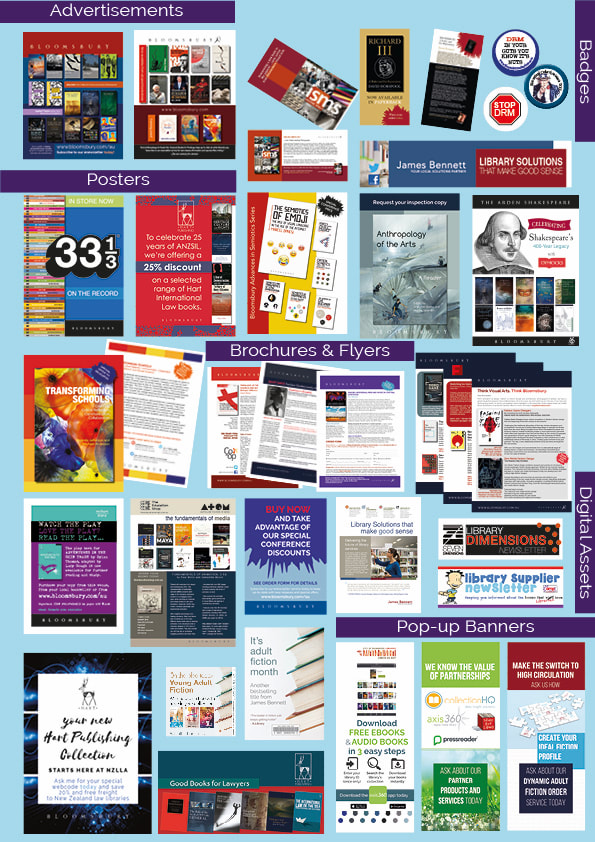|
Recently I was asked to do a presentation at UTS to a delegation of Chinese publishers on digital disruption in the Australian book industry in marketing and distribution. The organiser asked me to include some of the changes to publishing and distribution I've seen in the nearly three decades I've worked in the trade. When I was talking there were smiles as I summarised bits and pieces - now and then and the here and now - so I thought I'd share on the blog ...  There is no doubt whatsoever that technology has changed what we do, why we do it, how we do it. Digital is part of the every day and it’s hard to imagine life without the internet, apps, mobile devices etc. So to begin let’s wind the clock back three decades. What does Australian publishing look like? The bulk of titles, at least for the major and second tier publishers, were imported from UK and/or US head office distribution centres who had a strong say on what was purchased for the ANZ market. Local publishing programs existed particularly in educational publishing, and publishers distributed their titles through their own warehouse, often attached to their building. Orders were phoned, faxed (faxes had recently arrived in the workplace!) and mailed through to customer service, reps took orders when they called on booksellers or at the annual book fair which alternated between Sydney and Melbourne. Basic Bibliographic data was entered into distribution systems manually so orders could be keyed by data entry staff. Price and availability enquiries were predominantly done via the phone lines. Wait times could be long at busy periods. With regards to inventory: Buying in titles from overseas was done via catalogue information, published twice a year, with titles six months ahead of publication, and metadata which may or may not have been correct at the time of printing, rights information would always change. Textbooks were expensive (which has never changed) so academic publishers like Maxwell Macmillan where I first started my career would have an International Student edition printed, primarily out of Singapore, on cheaper paper and at a much cheaper price for students. We could price the books whatever we wanted to, marked up high for own margins. There was no goods and services tax. We would airfreight in a small number of copies for reps and marketing & publicity and the bulk came through ocean freight. It would take at least 3 months from the UK and 2 months from the US. If booksellers didn’t place their orders in a timely manner, they would not receive them for months unless they paid a special surcharge for us to air in. Orders to warehouses overseas were done every few weeks to consolidate. Everyone waited for their books. We were the only place they could get them. It was the norm. With regards to marketing: Marketing was much simpler. We did A LOT OF MAILINGS! There was one computer for marketing staff who had to book it in advance in order to create price lists and order forms in Wordperfect. We often only had US marketing materials and naturally Australian booksellers wanted to have prices in AUD. Design departments would also grow with graphic designers using Apple’s Pagemaker and they would create promotional materials for us. Four colour printing for marketing was unheard of. We often used the photocopier and may have even used colour paper to make something look more presentable. By the late 90s we could sent to a printer using 1 colour ink. That was very exciting. As there was of course no internet, we worked off US catalogues sometimes we wouldn’t find out we didn’t have the rights to sell a book in our region for months after we would take it to market – finding out only when we chased supply with our international warehouses or if a bookseller phoned us to say they had seen the same title from another publisher. Review copies with media releases were posted out extensively. Sometimes you even used the fax to send out media alerts. You often didn’t know when something was reviewed unless a bookseller mentioned it on the phone to customer service or you heard or watched it firsthand. We paid clipping services - an expensive service that would scan the print media and send clippings of all the reviews. They were like gold in your hand. Fast forward three decades to now.... It is rare for a publisher to do its own distribution unless you are one of the majors and you offer third party services to keep costs down and make some money from a competitor. Many publishers use a larger distribution centre and their software and workflows to manage their inventory. New title workflows vary between publishers but there will always be a trade release date for the majors so third party publishers have to make sure they have their stock in, inline with the release schedule. There are KPIs, there are penalties, and there are very real costs for storage of books, orders and returns. Every transaction has a fee. Large print runs are not normal except for first tier authors due to cost, space and risk. Printers turn around requests quickly – there is option for short runs and of course Print on Demand. Nielsen BookScan provides data to publishers on what books are selling through the registers at the bookstores and other channels. Publishers can better forecast when to press the reprint button. Technology and the information it provides has helped with inventory management and competitor information. It has also provided solutions.
You want to read the winner of the Booker prize which has just been announced on Twitter. Can’t access the print book? There is the option of immediately downloading the ebook when you purchase through Amazon, Apple, Kobo or see if it is available to borrow through your library through platforms like Overdrive, BorrowBox, Axis360. These digital suppliers are available via the web from your computer or through a handy app on your mobile device of choice. If it’s a scholarly book you would be looking for access through your university library. YOU expect access through the university library. And yes, you can now access etextbooks through vendors like Proquest and their Ebook Central Platform. Publishers will either do their own distribution of ebooks and upload them to multiple sales partners directly via FTP or will outsource this to other providers. Ingram for example plays a core role in both ebook distribution as well as some of the larger print distribution warehouses like IPG in the US. Many publishers have thriving local publishing programs. They make the decision locally as to what to import from their overseas offices and often do a local print run or format change rather than freighting books in – in this market we prefer trade paperbacks over the hardcovers for example. More often than not there are global release dates. Distributors of other publishers products release a month later when airfreight stock come in however others books that are not time sensitive still have a two month delay for their ocean freight to arrive to keep costs down. However they will have gone to market already with that title and have had some copies aired in. Orders from booksellers are sent via edi. Others are scanned and sent via email. Faxes still exist but many publishers don’t have one anymore, but the distributors do they have to for the older booksellers who still use them. Key accounts will have electronic workflows so they receive edi notifications, electronic invoices, advance shipping notices, credits, statements etc. Pricing of books has changed. The majority are overseas price converted plus GST (no markup as the customer will know – the customer is very savvy – the customer has the internet), some prices may even be cheaper than overseas however that presents problems for textbook publishers in particular who have a re-exportation issues which I won’t go into here. Price and availability is only a phone call to a distributor as a last resort. Your first point of call as a bookseller is Titlepage – the web based APA initiative that has about 80% of the industry onboard. If booksellers can’t find it on Titlepage they will then open up Baker & Taylor’s database or Ingram’s ipage. You then Google it to try and find the publisher directly. There are still calls to distribution call centres but most of the correspondence they receive is via email, particularly re order management so there is a written trail of correspondence and requests from customers. Booksellers don’t expect to wait for books. Ironically they can get overseas published books faster from the overseas wholesalers than from a local distributor. The way booksellers order has changed – smaller copies more frequently and of course expecting the publisher to have a consistent flow of stock to meet demand. They know they lost many consumers to Amazon and The Book Depository years ago so those booksellers who are still standing, and even thriving particularly independents and online, have to provide a high level of service locally for those that appreciate service above cost. It’s been estimated over many years that the Australian book market has lost between $200-300 million in sales to Amazon etc. I think it's more. Bibliographic data is comprehensive. ONIX is the standard for disseminating that information. Nielsen and Bowker have core roles to play with title data and of course Nielsen has BookScan which has revolutionised the way publishers receive information about the sell-thru of their titles and those of their competitors. Salesforce and other CRMs keep tabs on customers and business development opportunities. For those that require training on resources or who are very remote there is the option of Webex or Skype for Business etc. These days It’s about search and discovery. And the internet. And SEO. Don’t include an image and customers think it’s not available. No description. Customers will move on. Even the way publishers design their cover images has changed. They have to imagine how the cover looks like on the web and how to make it attractive (white covers are not practical unless they have interesting borders for example). Pricing. Consumers are pricing savvy. They know how to search for cheap books. Booko for example will collate information from the web and show them the prices offered by online booksellers and chains. So speed to market is critical. Competitive pricing and service are essential. These cost money but margins are being reduced on all sides in order to give the consumer what they want. What they demand. As without the customers everyone wouldn’t exist. Marketing has changed dramatically. Database marketing and analytics mean we know more about the customer better from their online activities. We know what they read, what they click through to, what they purchase. At least online. We have Google Alerts and Google Analytics. We have Google fullstop! Print promotional materials, particularly catalogues are less in demand, postage costs have almost disappeared as marketers have moved to email marketing. Marketing systems like Mailchimp, Marketo, Campaign Monitor, Constant Contact help profile customers and link into other systems effectively for better analytics. They are also free to a point. We have social media opportunities to explore all sides of publishing – Twitter, Facebook, Instagram, YouTube, Pinterest and others present different channels for sharing content, ideas and engagement – with authors, with consumers, with customers. Authors and author branding have become key in this online world as has genre marketing – sci-fi, romance and of course the big one YA. Event marketing, writers festivals, conferences have provided more avenues to reach both an existing and potential customer base. With the rise and rise of Print on Demand and better options for short run printing, publishers can produce Advance Reading Copies, often unedited, to get booksellers and reviewers engaged early. For those that prefer ebook over print there is NetGalley. Get them talking about forthcoming books using new channels and sites like GoodReads. Create a buzz. Hashtag. #itsallaboutthebuzz And when I say get “them” talking. I’m not talking about traditional book reviewers. The space in mainstream media for book reviewers has decreased. Literary editors predominantly review only books from the major publishers, with whom they have a direct relationship with their publicists. It’s the Instagrammers, The YouTubers “vloggers” that have social media influence and tens of thousands if not hundreds of thousands of followers who note their book recommendations. This is particularly strong in YA. And of course we have multiple formats of products – print, ebook, online, app. Digital has presented many opportunities to exploit content. And marketing has had to accommodate in all the different channels and vendor partners to support sales and product development. Print and promotional marketing still has a role but it is digital marketing has seen the most investment and focus from publishers.
0 Comments
I've been in the book industry since 1990 - when you still had a typewriter (and Tippex!) on your desk. Fax machines were still the most amazing invention (I never got sick of sending or receiving something on it - the idea of a fax machine blew my mind!) and eventually "The Work PC" entered the marketing department. Of course, we didn't have a PC EACH. No, no, we had to share. We had to allocate the number of hours each person could spend on "The Work PC" and beg with colleagues if you needed longer. The marketing staff all learnt how to design "flyers" in MS Word or Wordperfect and how to create a price list in tables in Excel. There was no formal training but luckily we worked for a publishing company that published books on computers - software and hardware - so we picked up one of the books and taught ourselves.
Over the years, as the software matured and became easier to use, we learnt how to "pretty something up" for an author or a customer. We concentrated on where to position images, how to ensure that all the features - and key selling points - of the book were highlighted, that all the essential information about the book were easy to find (price, ISBN, format, page count, pubdate, imprint - they are all drummed into me) and that we always had the right amount of information "about the author" (affiliations, career, other books etc). When the real designers (who did the cover art, posters, catalogues, direct marketing flyers and other corporate pieces) were busy you had to be able to pull something up quickly to meet a deadline. It had to be professional. And it had to be a good promotional piece - something that would encourage sales or publicity for the book/s you were promoting. You created templates. You worked out what worked and what didn't. And it became something so second nature you didn't think it was a skill at all. It was all on the job training. Wherever I have worked, I have always been the "go to" person for making something look good. Whether it was a professional business document or a comms piece one of the more senior managers had attempted (that had to be quickly rescued), I was their person. So I had to always extend my training to cover what they required. I learnt Pagemaker while doing my communications degree but did not have access to a Mac for a very long time. So I had to work in Word (urgh, the things you do....) or Publisher. It took over TWO DECADES before I started my own business and the first thing I made sure I had was a Mac and Adobe products like Indesign. And training. But I had the design elements already part of my publishing DNA. The rest was just navigating the software. Since April 2014 I've designed hundreds of brochures, dozens of posters and banners, social media assets, media releases, for all my clients. Digital assets (headers and other images) were required for enewsletters. Sometimes third parties wanted to have a range of banners to put on their website so you kept the core dimensions required by each customer and put something out that was professional, clean and sales-focussed. I created co-op materials with retail branding. Special order forms. Badges. Postcards. Fridge magnets. It's been an interesting few years.... I'm not a fancy designer but I know how to use Indesign. I use it every day. I dabble in Illustrator and have trained in Photoshop but I'm not one to manipulate photos and do "fancy fancy" things to graphics. In fact, for my own photos, I use other programs like Picasa and even just Apple photos to enhance photos. But yes, Photoshop can do amazing things and I can work my way around them if I need to. But Indesign is my software of choice. Someone recently asked me to put together a portfolio of my work. While I design promotional materials for clients, I don't consider myself a Designer. It's not a career move. I don't have the formal qualifications or the years and years of experience a graphic designer does. But what I do bring to the table is THOUSANDS and THOUSANDS of hours preparing sales promotional materials. I actually enjoy writing and creating a promotional piece for a client. I think it's the creative outlet I need to counter-act the business head that is required at other times. But am I actually a Designer or just the "Chief Pretty-Upp-er-re". Whatever I am, I can produce some professional and lovely works for a client so contact me today on [email protected] if you need some help with your promotional materials. Am I a designer? Take a look at some of the images below and tell me what you think in the comments. |
AuthorRachael McDiarmid has been in the Australasian book trade since 1990. Working in trade, academic and professional publishing as well as library supply and book distribution, she's worked with thousands of publishers, distributors, library vendors, and authors around the globe. She loves a belly laugh, strong coffee, wine, and good food. Venice is her favourite place in the world to visit but Sydney will always be home. She loves her office assistant Dash (also known as Dashie, Dashie Dog and the Little Shit). If you haven't already worked it out, she is known for her no bullshit approach. Archives
July 2024
Categories
All
|
Recommendations"Rachael is, quite simply, a book industry genius."
— Franscois McHardy, Former Managing Director, Simon & Schuster Australia "I thoroughly recommend her for her insights and intelligent analysis." — Terri-Ann White, Director, Upsell Publishing & Former Director, UWA Publishing |
for more recommendations please go to LinkedIn
|




 RSS Feed
RSS Feed